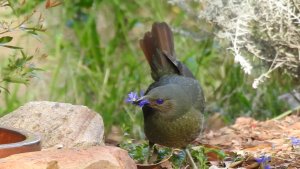You are here
Home ›Spring Survey Results are in...
A big thank you to all our Backyard Birders who, on top of the Aussie Bird Count, also did their Birds in Backyards Spring surveys.
1663 surveys came in across 603 locations and a lovely spread from towns and cities across Australia.
The top 10 birds recorded were not surprising – they are the ones we expect time and time again to be dominating our gardens. For those who are new to these reports, we often use ‘reporting rates’ to describe how common birds are. A reporting rate refers to the percentage of bird sightings or observations that are reported by our bird watchers compared to the total number of surveys that are sent in. So basically, how often that species shows up in the gardens surveyed.
Map shows the locations of all the Spring Surveys.
So our top 10 most frequently seen birds this spring (from the 342 species observed) were:
| Species | Reporting Rate (%) | |
1 | Rainbow Lorikeet | 46.36 |
| 2 | Australian Magpie | 42.45 |
| 3 | Noisy Miner | 31.93 |
| 4 | Sulphur-crested Cockatoo | 28.56 |
| 5 | Magpie-lark | 25.92 |
| 6 | Spotted Dove | 23.33 |
| 7 | Red Wattlebird | 22.55 |
| 8 | Willie Wagtail | 21.53 |
| 9 | Crested Pigeon | 21.23 |
| 10 | Little Wattlebird | 19.3 |
Interestingly, only one introduced bird, the Spotted Dove, was in that top 10 list – and it is always fantastic to see the Willie Wagtail showing up a lot in gardens.
But while these were the birds that showed up most often in the gardens surveyed – they weren’t the most abundant birds. In total 54706 birds were recorded – and the top 10 list of most abundant birds are not any of the top 10 most frequently seen!
| Species | Total Number | |
1 | Satin Bowerbird | 497 |
2 | Cattle Egret | 339 |
3 | Australian Wood Duck | 307 |
4 | White-plumed Honeyeater | 296 |
5 | Corella spp | 256 |
6 | White-headed Pigeon | 241 |
7 | Red-collared Lorikeet | 206 |
8 | Laughing Dove | 194 |
9 | White-gaped Honeyeater | 191 |
10 | Australian Ringneck | 163 |
While reporting rates provide insights into how often a particular bird is observed and reported, abundance measures the sheer number of individuals seen each survey (but remember, the same birds may be counted more than once if they show up on different days). Many of the birds in this top 10 list – like Cattle Egrets and White-headed Pigeons can be found in large flocks at any one time, so they might not be in many surveys, but when they turn up, they are a lot of them.
Satin Bowerbirds were surprisingly the most abundant bird reported. Over winter they often form large flocks but come spring, males are busy at their bowers – setting them up, decorating them and displaying to females. There is a flourish of activity – with females visiting the bowers around the neighbourhood and then heading off to raise her young alone, and males also getting around to their rivals in attempts to destroy their bowers or steal decorations. HANZAB reports that ‘Bower-owning adult males visit bowers of rival adult males and attempt to damage them or steal decorations, usually in mornings and afternoons, with destructive acts varying from complete levelling of bower to removal of a few sticks. Bower-owning adult males also regularly raid rudimentary bowers of younger males to destroy them or steal decorations.’ There can even be gangs of young males getting together to go and raid bowers. This all means that if you are lucky enough to have a bower in your garden, or even nearby, there is a lot of Satin Bowerbird action to be seen in spring!
And Satin Bowerbirds are not the only birds with a lot of activity observed this spring. In the Spring surveys this year we had reports of course the common urban birds like Australian Magpies, Torresian Crows, Noisy Friarbirds and Noisy Miners observed with nesting material or on the nest in some gardens. There were also some really exciting, less common birds seen in various stages of breeding - like a Whistling Kite seen carrying nesting material in Darwin, a Forest Kingfisher trying to excavate a termite nest for a hollow just outside Murwillumbah in northern NSW, Bush Stone-curlews on eggs in a garden west of Mackay Wedge-tailed Eagles on a nest on the outskirts of Melbourne, Australian Hobby chicks fledging in Nowra on the south coast of NSW, and even a male Cassowary with a 7 week old chick paying a visit to a North Queensland garden! How thrilling to see such a diverse range of birds breeding in our gardens – 60 species either with nesting materials or on a nest and 33 different species were seen with fledged young. Fingers crossed for good survival rates for those observed in these surveys. Don’t forget to keep surveying this summer to report on how they are going. If you are new to surveying, check out our recorded webinars on Birds in Backyards surveys and Bird ID for tips and tricks.
And remember if you have a Birdata account (which you do if you do Birds in Backyards surveys), dive into the Explore function to investigate more about the birds near where you live (and beyond!).










